Development of a Hardware Simulator for Reliable Design of Modular Multilevel Converters Based on Junction-Temperature of IGBT Modules
Abstract
:1. Introduction
2. Reliability of the IGBT Module
2.1. Cause of Failure in Standard IGBT Modules
2.2. Process of Lifetime Prediction for the IGBT Module
3. Modeling of Arm Current in MMC
4. Design of Hardware Simulator
4.1. Power-Converter Set
4.2. Load Reactor
4.3. Control Board
4.4. Fiber-Optic Temperature Sensor
5. Design of Arm Current Controller
5.1. Control of AC Component
5.2. Control of DC Offset
6. Experimental Results
7. Conclusions
Author Contributions
Funding
Conflicts of Interest
References
- Lee, K.B.; Lee, J.S. Reliability Improvement Technology for Power Converters; Springer: Singapore, 2017; ISBN 978-981-10-4991-0. [Google Scholar]
- Dong, P.; Lyu, J.; Cai, X. Modeling, analysis, and enhanced control of modular multilevel converters with asymmetric arm impedance for HVDC applications. J. Power Electron. 2018, 18, 1683–1696. [Google Scholar]
- Hu, P.; Chen, H.; Chen, L.; Zhu, X.; Wang, X. Advanced small-signal model of multi-terminal modular multilevel converters for power systems based on dynamic phasors. J. Power Electron. 2018, 18, 467–481. [Google Scholar]
- Kim, S.-H.; Kim, J.-S.; Kim, R.-Y.; Cho, J.-T.; Kim, S.-W. VPI-based control strategy for a transformerless MMC-HVDC system under unbalanced grid conditions. J. Electr. Eng. Technol. 2018, 13, 2319–2328. [Google Scholar]
- Hu, P.; Liang, Y.; Du, Y.; Bi, R.; Rao, C.; Han, Y. Development and testing of a 10 kV 1.5 kA mobile DC de-icer based on modular multilevel converter with STATCOM function. J. Power Electron. 2018, 18, 456–466. [Google Scholar]
- Quach, N.-T.; Chae, S.H.; Ahn, J.H.; Kim, E.-H. Harmonic analysis of a modular multilevel converter using double fourier series. J. Electr. Eng. Technol. 2018, 13, 298–306. [Google Scholar]
- Meshram, P.M.; Borghate, V.B. A simplified nearest level control (NLC) voltage balancing method for modular multilevel converter (MMC). IEEE Trans. Power Electron. 2015, 30, 450–462. [Google Scholar] [CrossRef]
- Perez, M.A.; Bernet, S.; Rodriguez, J.; Kouro, S.; Lizana, R. Circuit topologies, modelling, control schemes and applications of modular multilevel converters. IEEE Trans. Power Electron. 2015, 30, 4–17. [Google Scholar] [CrossRef]
- Kim, S.M.; Jeong, M.G.; Kim, J.; Lee, K.B. Hybrid modulation scheme for switching loss reduction in a modular multilevel high-voltage direct current converter. IEEE Trans. Power Electron. 2019, 34, 3178–3191. [Google Scholar] [CrossRef]
- Kim, S.M.; Lee, J.S.; Lee, K.B. A novel modulation method for half-Bridge based modular multilevel converter under submodule failure with reduced switching frequency. In Proceedings of the Applied Power Electronics Conference and Exposition, Anaheim, CA, USA, 17–21 March 2019; pp. 620–624. [Google Scholar]
- Abdelsalam, M.; Marei, M.I.; Diab, H.Y.; Tennakoon, S.B. A Fault tolerant control technique for hybrid modular multi-level converters with fault detection capability. J. Power Electron. 2018, 18, 558–572. [Google Scholar]
- Zhang, Y.; Wang, H.; Wang, Z.; Yang, Y.; Blaabjerg, F. Simplified thermal modeling for IGBT modules with periodic power loss profiles in modular multilevel converters. IEEE Trans. Ind. Electron. 2019, 66, 2323–2332. [Google Scholar] [CrossRef]
- Im, W.S.; Kim, J.S.; Kim, J.M.; Lee, D.C.; Lee, K.B. Diagnosis methods for IGBT open switch fault applied to 3-phase AC/DC PWM converter. J. Power Electron. 2012, 12, 120–127. [Google Scholar] [CrossRef]
- Liu, H.; Ma, K.; Qin, Z.; Loh, P.C.; Blaabjerg, F. Lifetime estimation of MMC for offshore wind power HVDC application. IEEE J. Emerg. Sel. Top. Power Electron. 2016, 4, 504–511. [Google Scholar] [CrossRef]
- Choi, U.M.; Blaabjerg, F.; Lee, K.B. Study and handling methods of power IGBT module failures in power electronics converter systems. IEEE Trans. Power Electron. 2015, 30, 2517–2533. [Google Scholar] [CrossRef]
- Haleem, N.M.; Rajapakse, A.D.; Gole, A.M. Improved circuit model for simulating IGBT switching transients in VSCs. J. Power Electron. 2018, 18, 1901–1911. [Google Scholar]
- Ji, B.; Song, X.; Sciberras, E.; Cao, W.; Hu, Y.; Pickert, V. Multi objective design optimization of IGBT power modules considering power cycling and thermal cycling. IEEE Trans. Power Electron. 2015, 30, 2493–2504. [Google Scholar] [CrossRef]
- Andresen, M.; Liserre, M.; Buticchi, G. Review of active thermal and lifetime control techniques for power electronic modules. In Proceedings of the 16th European Conference on Power Electronics and Applications, Lappeenranta, Finland, 26–28 August 2014; pp. 1–10. [Google Scholar]
- Li, H.; Hu, Y.; Liu, S.; Li, Y.; Liao, X.; Liu, Z. An improved thermal network model of the IGBT module for wind power converters considering the effects of base-plate solder fatigue. IEEE Trans. Device Mater. Reliab. 2016, 16, 570–575. [Google Scholar] [CrossRef]
- Wang, Z.; Qiao, W. A physics-based improved cauer-type thermal equivalent circuit for IGBT modules. IEEE Trans. Power Electron. 2016, 31, 6781–6786. [Google Scholar] [CrossRef]
- Chung, H.S.H.; Wang, H.; Blaabjerg, F.; Pecht, M. Reliability of Power Electronic Converter Systems; Institution of Engineering and Technology: London, UK, 2016; ISBN 978-1-84919-901-8. [Google Scholar]
- Kim, S.M.; Lee, K.B. Control method of power cycling test setup for submodule reliability investigation of modular multilevel converters. In Proceedings of the ICEE 2018 Conference, Seoul, Korea, 24–28 June 2018. [Google Scholar]
- Choi, U.M.; Blaabjerg, F.; Jorgensen, S. Power Cycling Test Methods for Reliability Assessment of Power Device Modules in Respect to Temperature Stress. IEEE Trans. Power Electron. 2018, 33, 2531–2551. [Google Scholar] [CrossRef]
- Smet, V.; Forest, F.; Huselstein, J.J.; Rashed, A.; Richardeau, F. Evaluation of Vce monitoring as a real-time method to estimate aging of bond wire-IGBR modules stressed by power cycling. IEEE Trans. Ind. Electron. 2013, 60, 2760–2770. [Google Scholar] [CrossRef]
- Smet, V.; Forest, F.; Huselstein, J.J.; Rashed, A.; Richardeau, F.; Khatir, Z.; Lefebvre, S.; Berkani, M. Ageing and failure modes of IGBT modules in hightemperature cycling. IEEE Trans. Ind. Electron. 2011, 58, 4931–4941. [Google Scholar] [CrossRef]
- De Vega, A.R.; Ghimirel, P.; Pedersen, K.B.; Trintisl, I.; Beczckowski, S.; Munk-Nielsen1, S.; Rannestad, B.; Thogersen, P. Test setup for accelerated test of high power IGBT modules with online monitoring of Vce and Vf voltage during converter operation. In Proceedings of the 2014 International Power Electronics Conference, Hiroshima, Japan, 18–21 May 2014; pp. 2547–2553. [Google Scholar]
- Trintis, I.; Ghimire, P.; Munk-Nielsen, S.; Rannestad, B. On-state voltage drop based power limit detection of IGBT inverters. In Proceedings of the 2015 17th European Conference on Power Electronics and Applications, Geneva, Switzerland, 8–10 September 2015; pp. 1–9. [Google Scholar]
- Ghimire, P.; de Vega, A.R.; Beczkowski, S.; Rannestad, B.; Munk-Nielsen, S.; Thogersen, P.B. An online Vce measurement and temperature estimation method for high power IGBT module in normal PWM operation. In Proceedings of the 2014 International Power Electronics Conference, Hiroshima, Japan, 18–21 May 2014; pp. 2850–2855. [Google Scholar]
- Denk, M.; Bakran, M. Junction temperature measurement during inverter operation using a TJ-IGBT-driver. In Proceedings of the PCIM Europe 2015, Nuremberg, Germany, 19–20 May 2015; pp. 1–8. [Google Scholar]
- Jeong, H.G.; Kim, G.S.; Lee, K.B. Second-order harmonic reduction technique for photovoltaic power conditioning systems using a proportional-resonant controller. Energies 2013, 6, 79–96. [Google Scholar] [CrossRef]
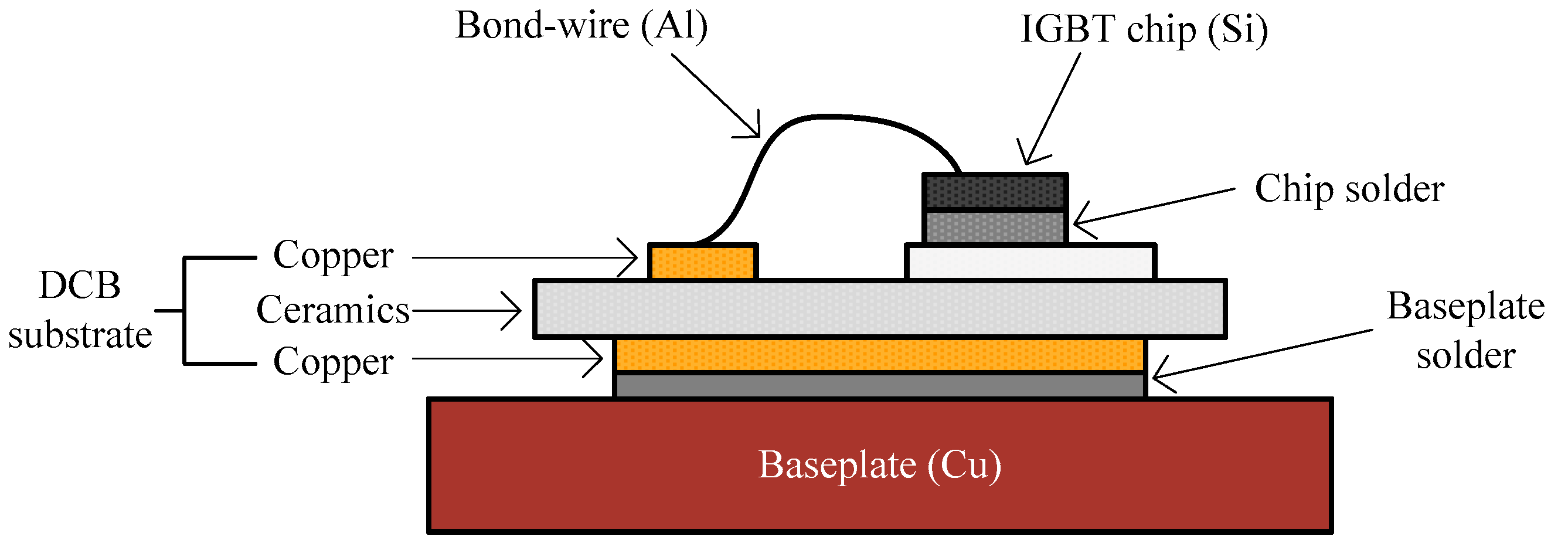


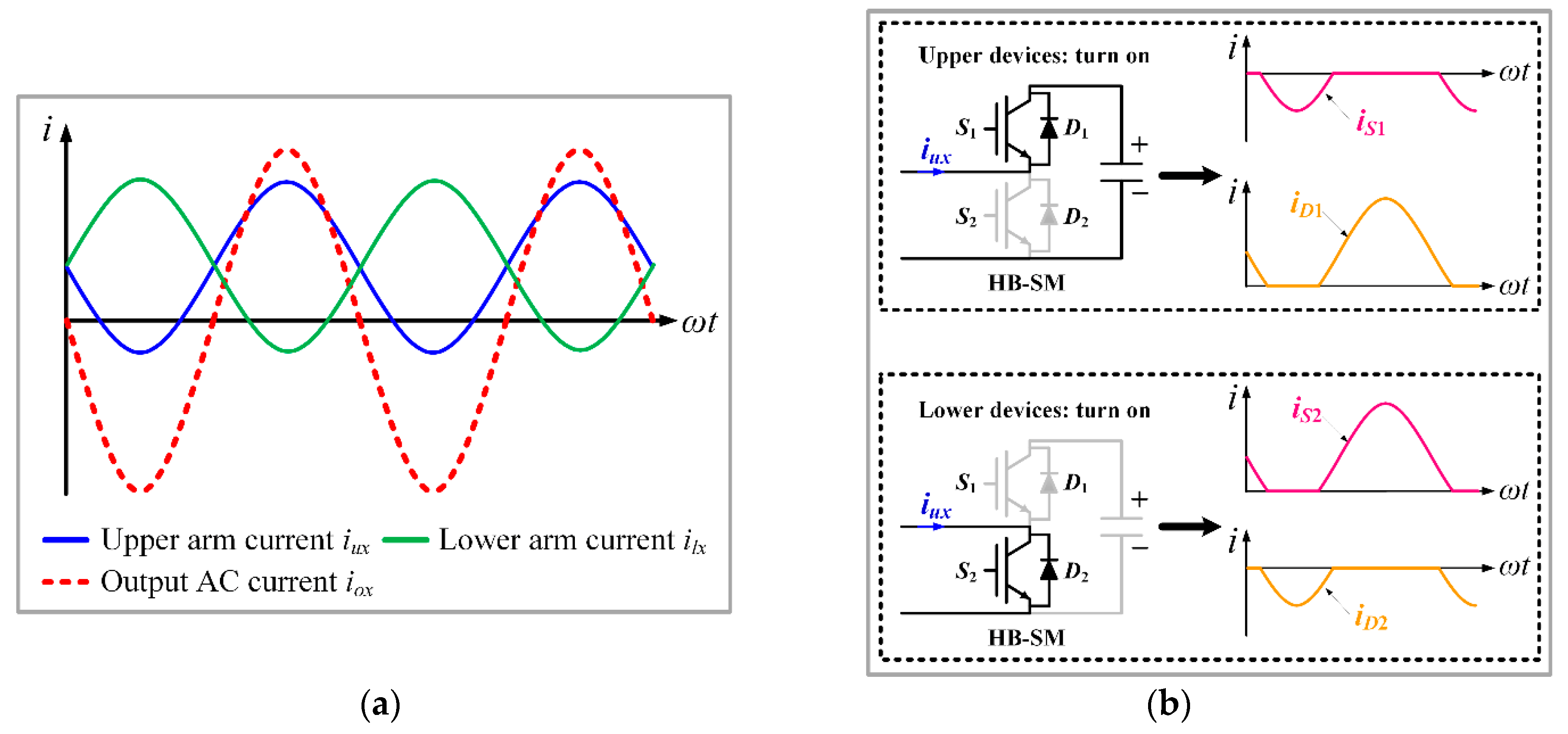
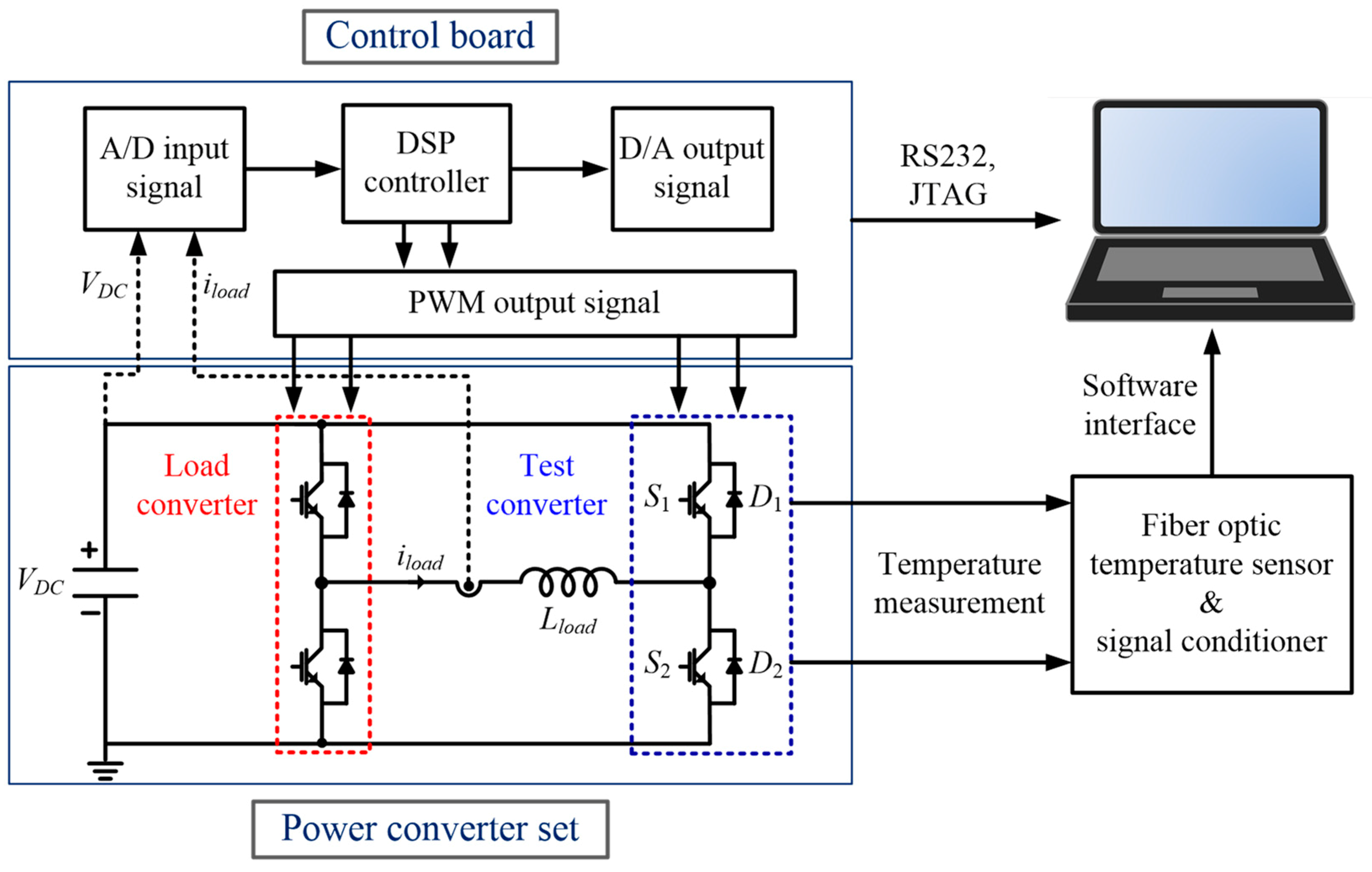


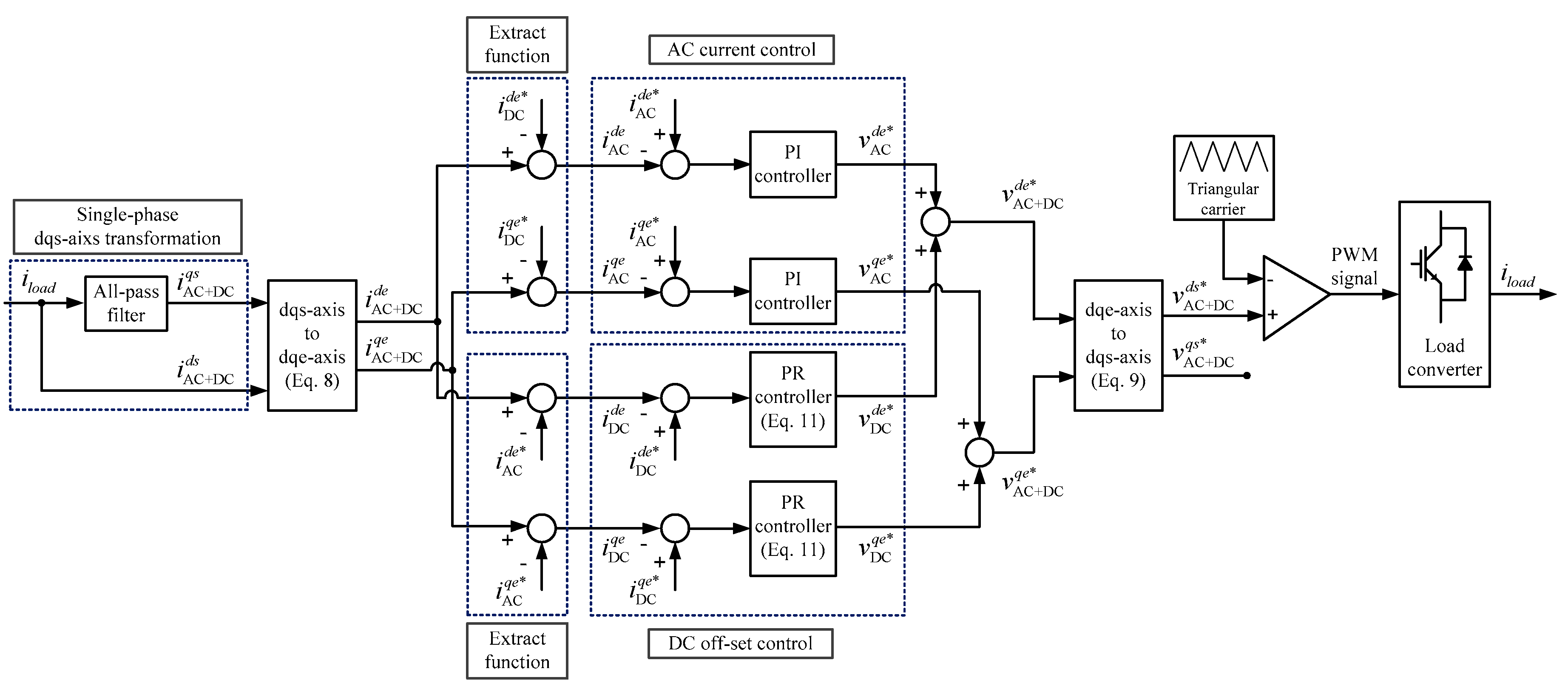
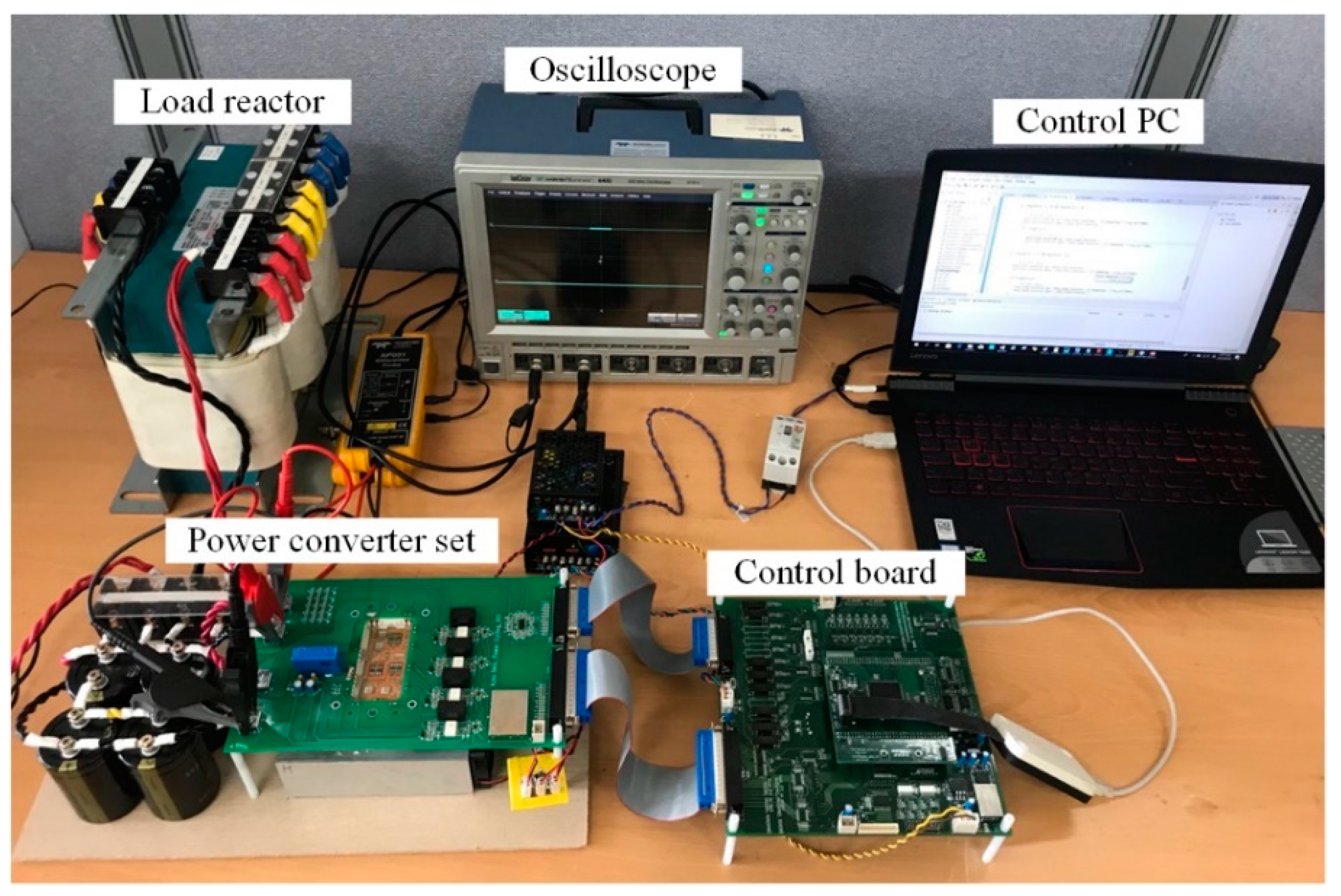
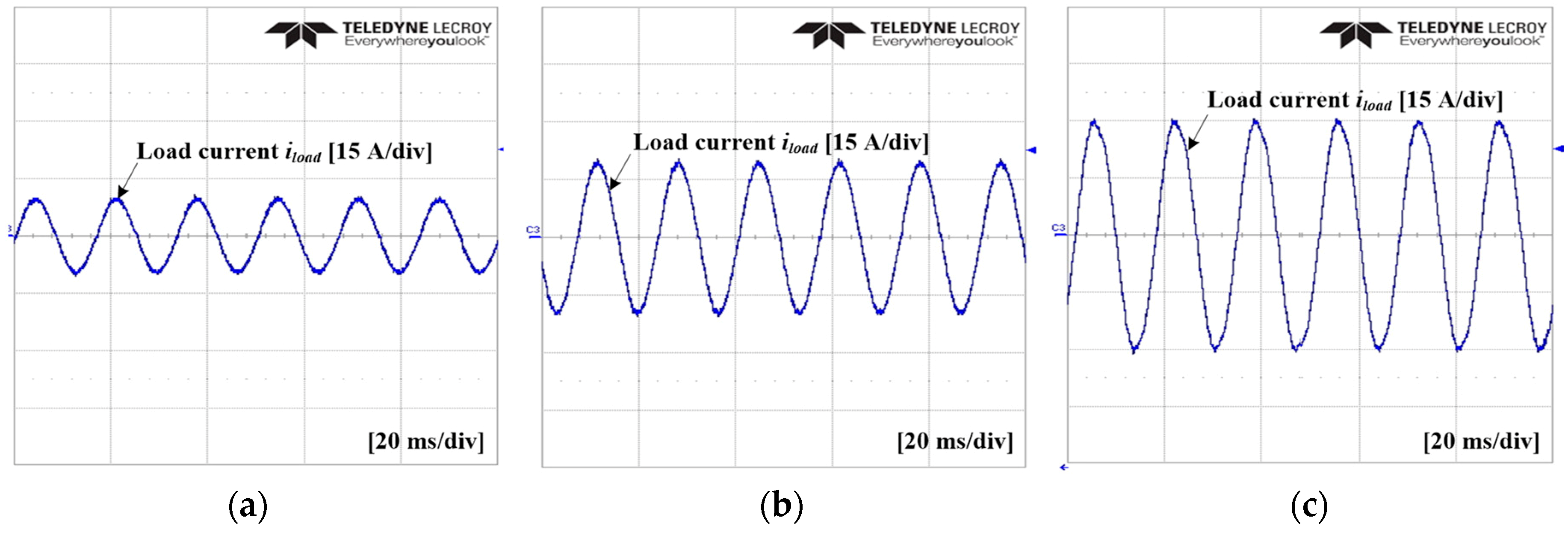
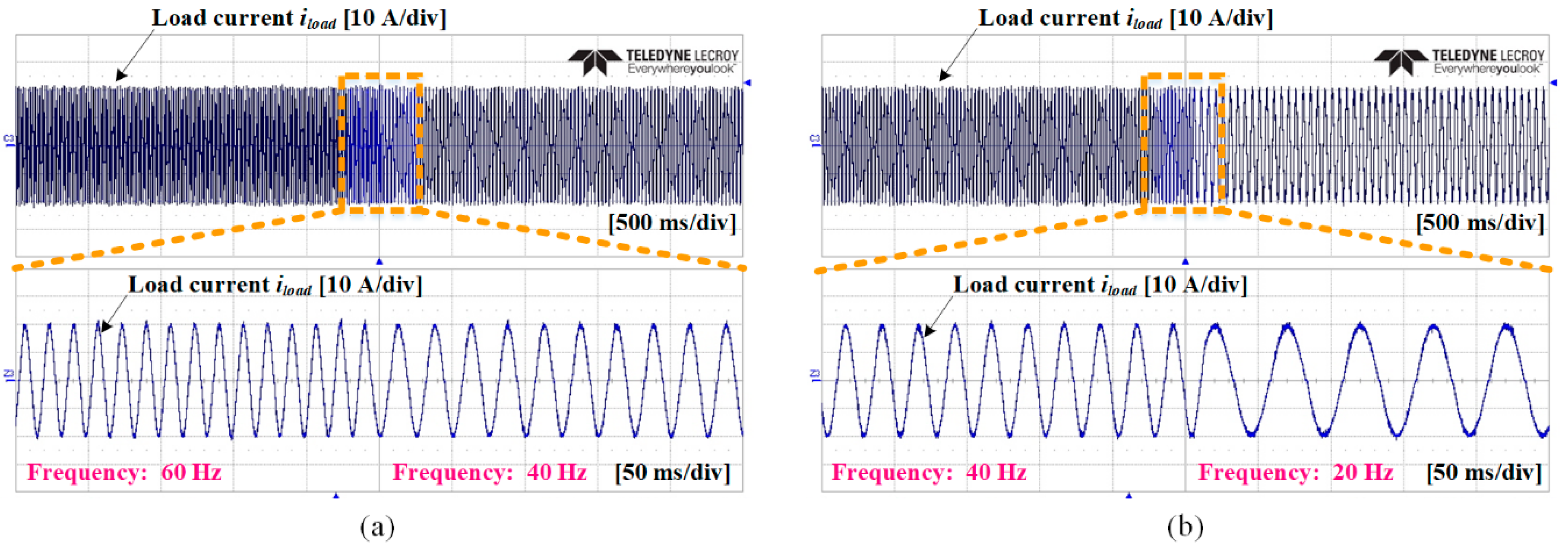
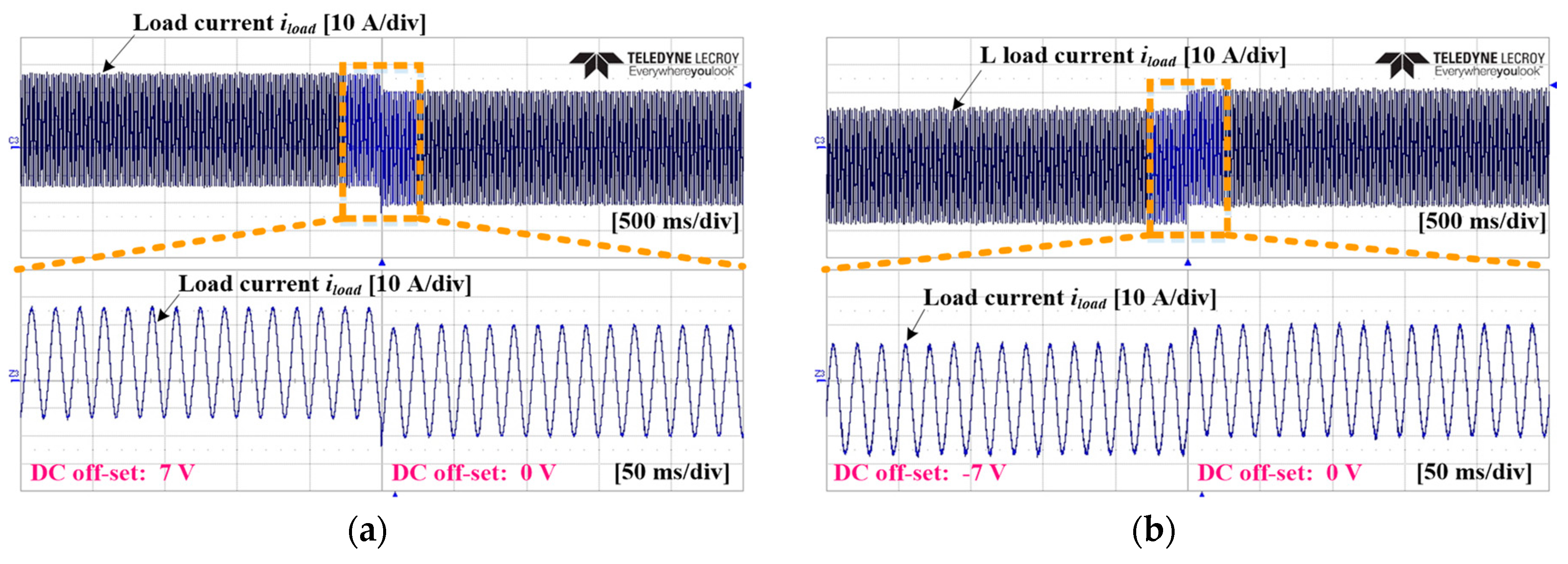
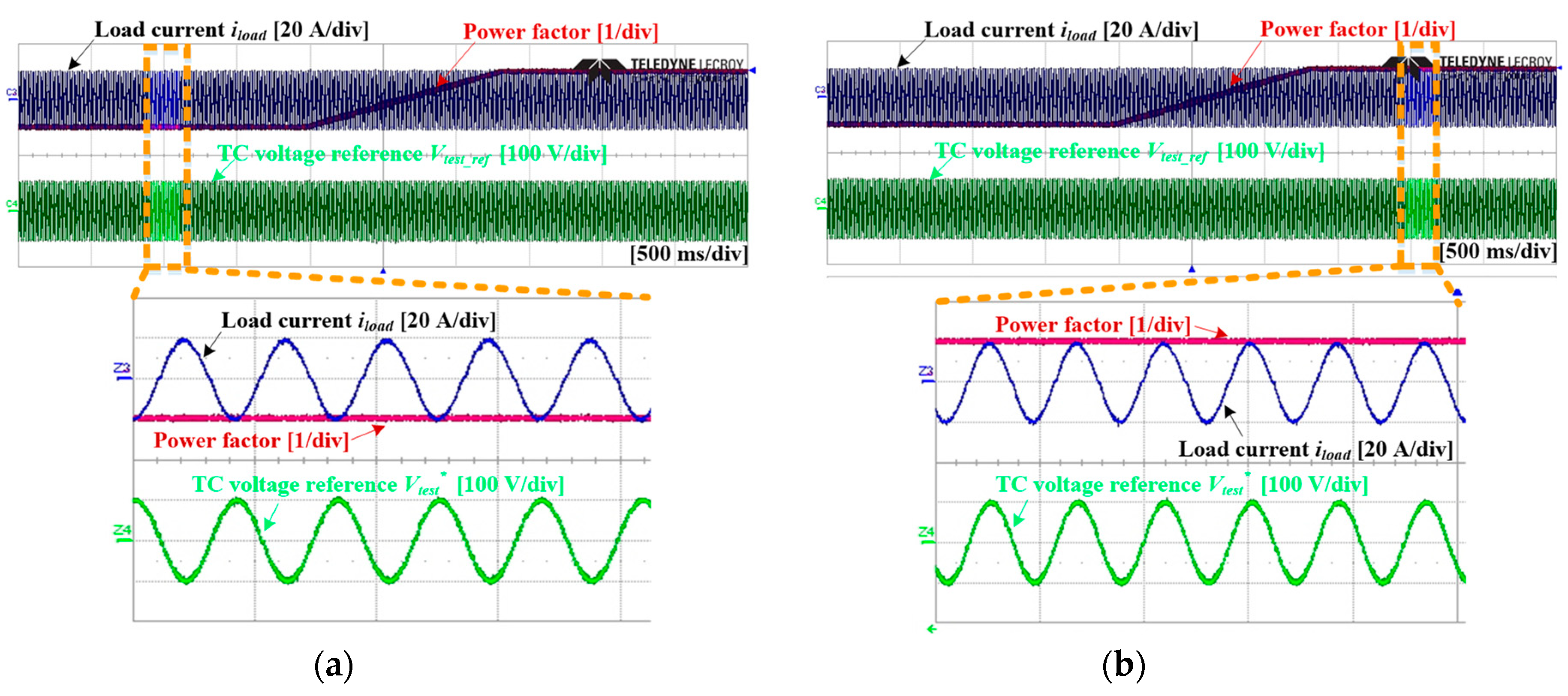



| Failure Mechanism | Failure Site | Failure Mode | Main Cause |
|---|---|---|---|
| Bond-wire fatigue | Bond wires | Open circuit | ∆T, T |
| Metallization | IGBT and diode | Open circuit | ∆T, T |
| Solder fatigue | Solder joints | Open circuit | ∆T, T |
| Gate-oxide failure | IGBT oxide | Closed circuit | T, V, E |
| Burnout failure | IGBT and diode | Closed circuit | T, E, overvoltage |
| Parameters | Value | Unit |
|---|---|---|
| DC-link voltage | 300 | V |
| Load reactor | 2 | mH |
| DC-link capacitance | 500 | μF |
| Test converter voltage reference | 100 | Vpeak |
| Carrier frequency | 10 | kHz |
| Sampling time | 100 | μs |
© 2019 by the authors. Licensee MDPI, Basel, Switzerland. This article is an open access article distributed under the terms and conditions of the Creative Commons Attribution (CC BY) license (http://creativecommons.org/licenses/by/4.0/).
Share and Cite
Jo, S.-R.; Kim, S.-M.; Cho, S.; Lee, K.-B. Development of a Hardware Simulator for Reliable Design of Modular Multilevel Converters Based on Junction-Temperature of IGBT Modules. Electronics 2019, 8, 1127. https://doi.org/10.3390/electronics8101127
Jo S-R, Kim S-M, Cho S, Lee K-B. Development of a Hardware Simulator for Reliable Design of Modular Multilevel Converters Based on Junction-Temperature of IGBT Modules. Electronics. 2019; 8(10):1127. https://doi.org/10.3390/electronics8101127
Chicago/Turabian StyleJo, Seung-Rae, Seok-Min Kim, Sungjoon Cho, and Kyo-Beum Lee. 2019. "Development of a Hardware Simulator for Reliable Design of Modular Multilevel Converters Based on Junction-Temperature of IGBT Modules" Electronics 8, no. 10: 1127. https://doi.org/10.3390/electronics8101127
APA StyleJo, S.-R., Kim, S.-M., Cho, S., & Lee, K.-B. (2019). Development of a Hardware Simulator for Reliable Design of Modular Multilevel Converters Based on Junction-Temperature of IGBT Modules. Electronics, 8(10), 1127. https://doi.org/10.3390/electronics8101127







